-
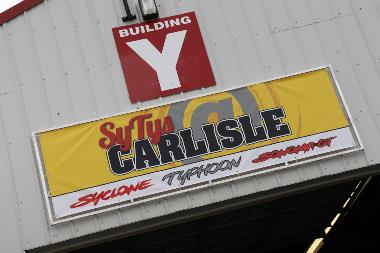
History of Syclones and Typhoons
Tuesday, Mar 30, 2021
If you are a devout truck enthusiast or even a casual fan, you find something special in the genre. To those of us who are “truck people,” every tr …
Show MoreIf you are a devout truck enthusiast or even a casual fan, you find something special in the genre. To those of us who are “truck people,” every truck is special, but some stand out more than others do.
The evolution of trucks, from steam wagons in the 1770s, to the internal combustion trucks of Karl Benz in 1895 and Gottlieb Daimler in 1896 has evolved into today’s diesel and turbo trucks and electric and hybrid models. The genre of truck may have started with pick-ups, 18-wheelers, tow trucks, and three-quarter-ton representations, but the niche has grown to include, vans, compact trucks, sport trucks, and the most popular derivation outside full-sized trucks in today’s marketplace, the sports-utility-vehicle, or SUV. In fact, as a group, SUVs are currently the world's largest automotive segment, accounting for nearly 50 percent of the world's passenger car market in 2020.
During the late 1990s and early 2000s, the popularity of SUVs greatly increased, and along the way, sports-ute stars have come and gone. During that time, another genre has gained popularity, the sport truck.
A sport truck is for the “more power” crowd. A sport truck is any truck that has been modified for enhanced appearance and/or performance.
Today, the power, the cosmetics and accouterments are limited only by imagination, but back in the day, a sport truck and an SUV stand out. Limiting the scope to just these two, a turbocharged SUV and its sibling, a sport truck, attacked the market. These pioneers brought performance, big horsepower, and sportscar-killing performance to the truck and SUV niche before the uptweak became commonplace. These two vehicles were GMC’s Syclone compact pickup and Typhoon SUV, revered and followed today by numerous “SyTy” forums.
GMC SYCLONE
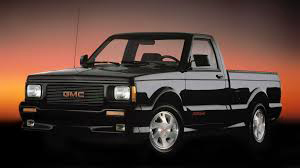
The GMC Syclone was a high-performance version of the GMC Sonoma pickup truck, with 2,998 units produced in 1991 and ’92 by GMC along with Production Automotive Services (PAS). Following the Syclone, the 1992 GMC Sonoma GT truck was offered as a sport package with the looks of a Syclone but without the price and performance of its turbocharged predecessor.Legend has it that Syclone with an "S” was an homage to the “S-10” or “Sonoma”, but Mercury had already produced the Cyclone (with a “C”) from 1964-’71 and GMC did not want to copy that name representation.
Measuring 180.5 inches long, 68.2 inches wide and 60.0 inches high on a 108.3-inch wheelbase, Syclones powered up with a 280hp 4.3-liter turbo V-6. Weighing in at 3,599 lbs., and mated to a 4-speed 4L60 automatic transmission, Syclones were timed in a 4.3-second zero-to-60mph sprint and a 13.4-second quarter-mile.
Engine modifications included lower-compression pistons, special intake and exhaust manifolds, a multipoint fuel injection system, bigger twin-bore throttle body from Corvette's 5.7-liter small-block, and a Mitsubishi TD06-17C turbocharger with a Garrett water-to-air inter-cooler.
Syclone was meant for the street. Its cab carried a warning: "This vehicle is not intended for off-road use. The reduced height of this vehicle will not allow it to clear obstacles commonly encountered in an off road environment. Off road operation could result in serious damage to chassis and drivetrain.” In addition, it wasn’t meant to haul. Syclone had a 500-pound payload capacity, low for a pick-up, and towing was not recommended by the factory.
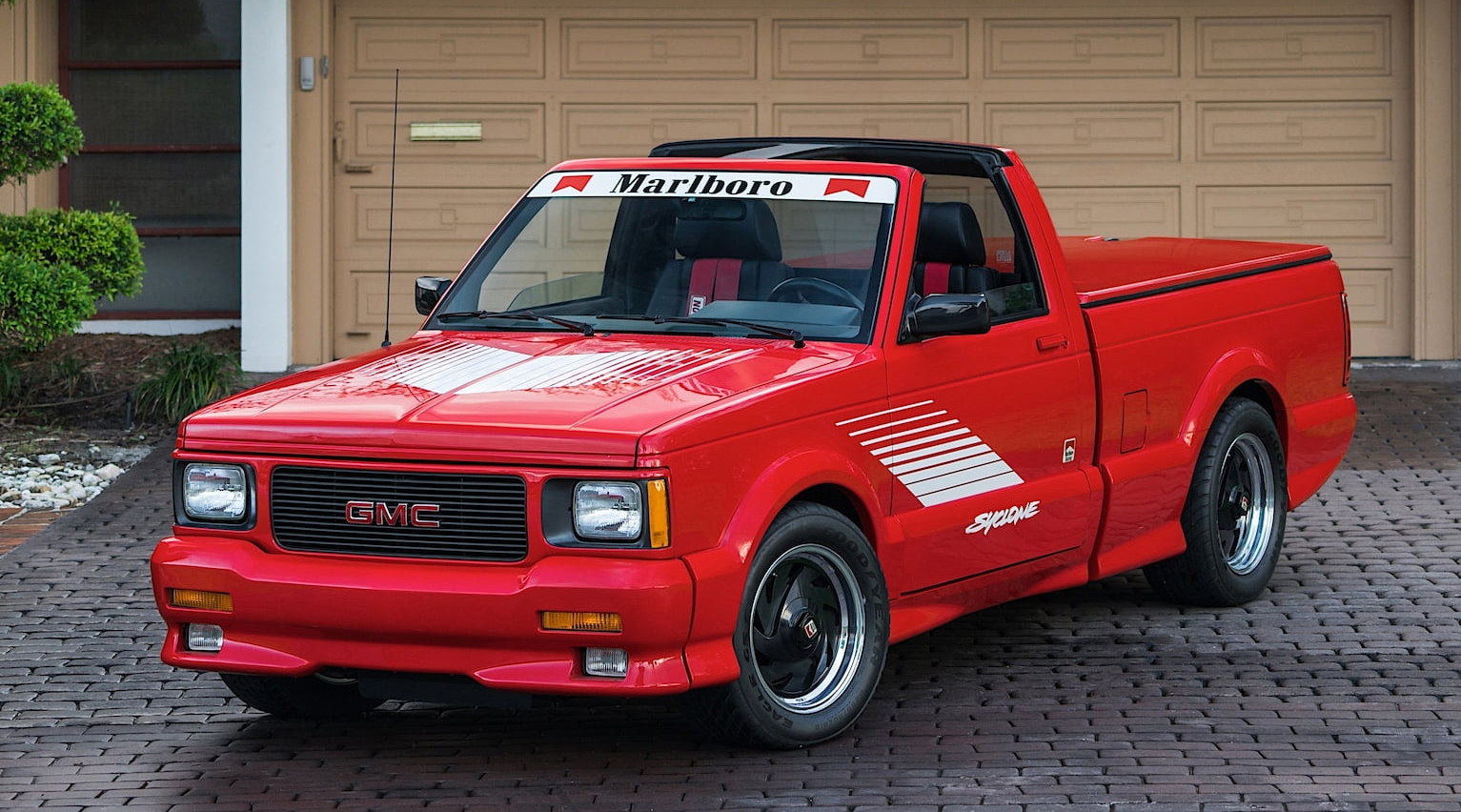 Syclone only came in black, except for a few third-party exceptions: The Red Marlboro Syclones customized by American Sunroof Company, and the Indy Syclone, used at the Indianapolis 500 race in 1992. Although there were three of these unofficial pace cars, only one (the PPG version) got a multi-colored silver, magenta, and aqua paint scheme, while the other two got sticker packages.
Syclone only came in black, except for a few third-party exceptions: The Red Marlboro Syclones customized by American Sunroof Company, and the Indy Syclone, used at the Indianapolis 500 race in 1992. Although there were three of these unofficial pace cars, only one (the PPG version) got a multi-colored silver, magenta, and aqua paint scheme, while the other two got sticker packages. 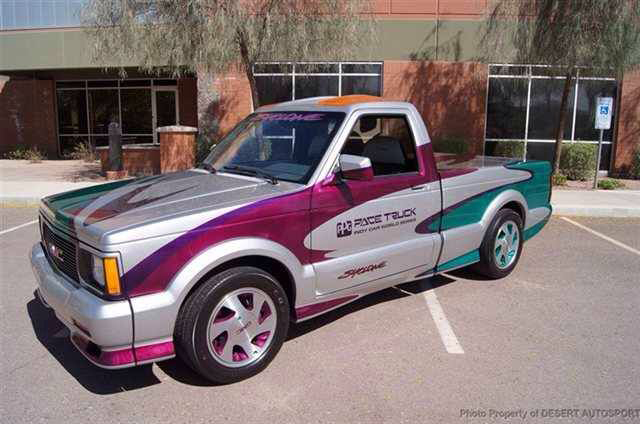
Marlboro Syclones featured Boyd Coddington wheels, Recaro leather seats, a Momo steering wheel, and a targa-style removable roof panel. The Indy had a racing fuel cell, a built-in halon fire suppression system, water-cooled brakes, and color matched leather interior to the exterior paint scheme. The bed had a multi piece tonneau cover that accordion folds with the tailgate to reveal the fuel cell, halon canister mounts and a molded in light bar in the roof.A GMC ad for the Syclone compared it to a Porsche 911 Carrera 4, with the ad headline: "Think of it as a Porsche 911 that really hauls.”
GMC Typhoon
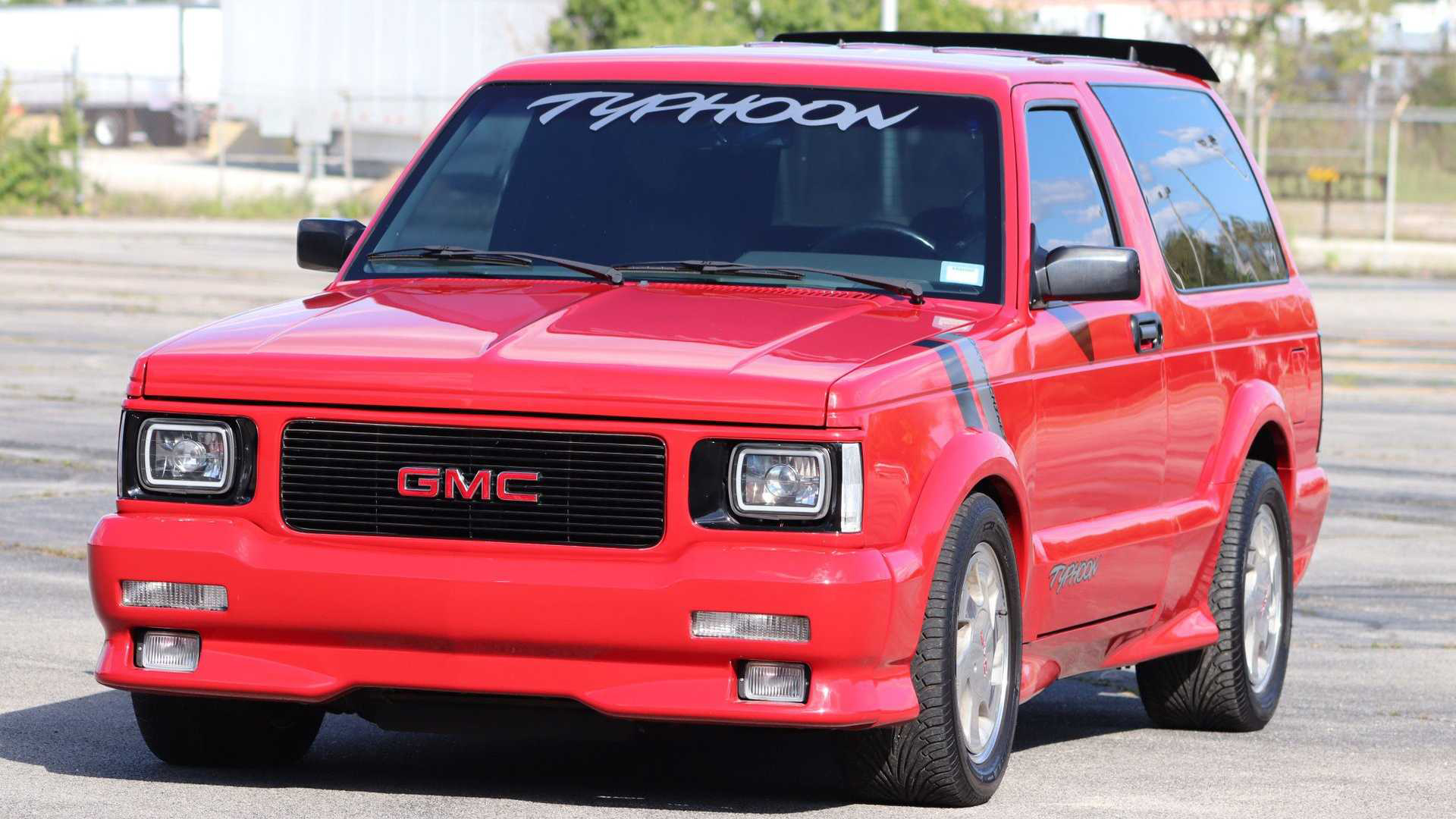 Based on the GMC Jimmy, General Motors produced 4697 Typhoons from 1991-1993. The two-door mid-size SUV was powered by the same modified turbocharged 4.3-liter V-6 that powered the Syclone, although Typhoon’s transfer case was a BorgWarner 4472 – Syclone used a BorgWarner 1372). Like the Sy, the Ty system also produced 280hp and 350 lb-ft. of torque. The Ty had a 100.5-inch wheelbase and measured 170.3 inches long, 68.2 inches wide and 60.0 inches high, weighing in with a curb weight of 3822 lbs. The manufacturer touted a 5.3-second zero-to-60mph dash, and the SUV ran a 14.1-second quarter-mile.
Based on the GMC Jimmy, General Motors produced 4697 Typhoons from 1991-1993. The two-door mid-size SUV was powered by the same modified turbocharged 4.3-liter V-6 that powered the Syclone, although Typhoon’s transfer case was a BorgWarner 4472 – Syclone used a BorgWarner 1372). Like the Sy, the Ty system also produced 280hp and 350 lb-ft. of torque. The Ty had a 100.5-inch wheelbase and measured 170.3 inches long, 68.2 inches wide and 60.0 inches high, weighing in with a curb weight of 3822 lbs. The manufacturer touted a 5.3-second zero-to-60mph dash, and the SUV ran a 14.1-second quarter-mile.Typhoon paint colors included Forest Green Metallic, Radar Blue, Raspberry Metallic, Frost While, Royal Blue Metallic, Aspen Blue, Bright Teal, Apple Red, Garnet Red, and black, and it was a favorite among celebrities.
Among those big names who owned Typhoons were Clint Eastwood, John F. Kennedy Jr., Bob Seger, and two Miami Dolphins players – Brian Cox and O.J. McDuffie.
You can see Syclones, Typhoons in Building Y this year presented by the SyTy’s at Carlisle club display. In addition, also at Carlisle are all manners of trucks, from the early days to the present, from the antique to the modern and from the iconic to the obscure, at the Carlisle Truck Nationals presented by A&A Auto Stores August 6-8 at the Carlisle, PA Fairgrounds.
> Visit www.CarlisleEvents.com for more on the automotive hobby.
Mike Blake, former editor of KIT CAR magazine, joined Carlisle Events as senior automotive journalist in 2004. He's been a "car guy" since the 1960s and has been writing professionally for about 30 years. </I>
-
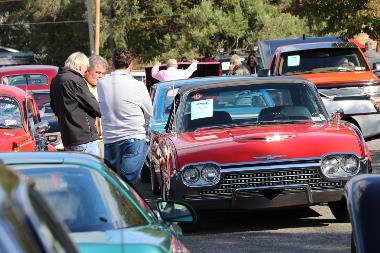
Carlisle Auctions’ Second 2021 Offering Kick-Starts Carlisle PA Auction Season
Tuesday, Mar 30, 2021
Spring Carlisle presented by eBay Motors returns to its normal late April time frame (21-25) in 2021 and with it comes non-stop automotive fun span …
Show MoreSpring Carlisle presented by eBay Motors returns to its normal late April time frame (21-25) in 2021 and with it comes non-stop automotive fun spanning hundreds of acres and two facilities. While Spring Carlisle itself might offer a shopping bonanza for some, others flock to the Carlisle Expo Center for the chance to enjoy LIVE collector car auction excitement April 22-23. Carlisle Auctions offers THREE great ways to bid; in person, on the phone or online and for those who pre-register to bid and want to bid online, that process can start right away.
As the anticipation builds for the auction and consignments are checked in, enthusiasts who want to look and serious buyers looking to add a nice piece to their collection can preview what’s on tap starting April 21. From there, nearly every car will be in place for the event by 7 a.m. on April 22. Carlisle Auctions will start the bidding fun each day at 12 p.m. and by doing so, gives everyone in attendance even more of the fun they’ve come to know from Carlisle Auctions.
Carlisle Auctions is in the giving spirit for 2021 as well, moving select lots for charity. This includes (as of press time) a beautiful 1964 Cadillac Eldorado and a wooden American Flag art piece. The car comes to Carlisle Auctions by way of the Williamsport, Maryland Volunteer Fire Company & EMS, while the flag art is courtesy of the Cumberland Valley Corvette Club. There will also be a 2015 Ford Mustang Ecoboost Coupe, #9 of 30. Proceeds from this sale benefit the Rescue 22 Foundation. 100% of the sales from these items will benefit the fire company and Warrior Project, respectively.
The two-day event not only presents the aforementioned charity items but will also offer an all-truck specialty hour on April 22. This hour spotlights all things truck and should see about two dozen trucks of various styles, size and era cross the block.
“We are thrilled to offer our second auction of the season in Carlisle,” noted Tony Cline, Director of Auction Operations. “We are eager to showcase and sell the consignments we have to date but we are also actively looking for more. If you have a vehicle that you’d like to sell, call us today to reserve your spot. We can’t wait to have you as part of this fantastic auction starting April 22.”
Vehicles will begin loading in on Tuesday, April 20. All outdoor placements can be viewed by one and all, but ONLY event staff, registered buyers/sellers and guests and select business partners are permitted to enter the Expo Center during the auction. Due to gathering restrictions, general spectators are restricted from entering the Expo Center. If a desired lot doesn’t sell, Carlisle Auctions offers a “Still for Sale” option for one last chance at connecting seller and buyer person to person and away from the spotlight of the auction block. “Still for Sale” is available starting April 22 and is available in person for a few days following the event in person and online at www.CarlisleAuctions.com for approximately three weeks.
Carlisle Auctions is COVID-19 compliant and follows current guidelines suggested by state officials as well as the Centers for Disease Control (CDC). A detailed Health/Safety Measures summary is available on CarlisleAuctions.com. While on the web, be sure to learn more about the Spring Carlisle Collector Car Auction, consign to sell, or as noted, register to bid and view committed consignments. Learn more online or call 717-960-6400 today.
-

1964 Cadillac Eldorado to Cross the Auction Block and Benefit Small Town Maryland First Responders
Wednesday, Mar 24, 2021
Carlisle Auctions has been connecting enthusiasts with cars for sale by way of auction for some time. Often, a sale means the buyer gets the …
Show MoreCarlisle Auctions has been connecting enthusiasts with cars for sale by way of auction for some time. Often, a sale means the buyer gets the ride of their choice, while the seller and auction house financially benefit. On Thursday, April 22, one person will go home with a car, but the party that benefits the most will be a group of first responders in Williamsport, Maryland.
Carlisle Auctions two-day event runs April 22-23 at the Carlisle Expo Center and happens in conjunction with Spring Carlisle presented by eBay Motors (April 21-25) at the Carlisle PA Fairgrounds. The auction sees nearly 100 years of history cross the block and upwards of 400 consignments committed to sell. One such consignment, a 1964 Cadillac Eldorado, has been designated as a charity car. The car, donated by a local Williamsport, Maryland resident, will see 100% of its sales benefit the Williamsport Volunteer Fire & EMS in Williamsport, Maryland. For them, that means the purchase, maintenance and operation of emergency life-saving equipment needed to protect the town of Williamsport and its surrounding areas.
While this isn’t the first car tapped for charity that Carlisle Auctions will sell, it is the first where dollars go directly to first-responders and their needs for the community they cover. This car, while not 100% original, is of survivor quality and definitely a daily driver. Like many rides of its age, there are some cosmetic blemishes, but it comes with four new tires, a cleaned-out fuel system, new convertible top motor and more! Best of all, it’s basically been in storage since 1991 and when you register to bid with Carlisle Auctions by calling 717-960-6400, you can bid online today, or by phone or in person at the event.
“The owner came to our Deputy Chief and said that he wanted to donate a car to the fire department,” noted Kimble, Vice President of Williamsport Volunteer Fire and EMS. “We were amazed when we saw what he was offering us because normally, donated cars aren’t road worthy, they are the type that we’d use for extraction or rescue practice. This one…this was very different,” continued Kimble. “Due to COVID, we had to cancel all of our bingo events over the past year and while we did some raffles, the sale of this vehicle will go a long way towards our needs.”
In fact, their current needs include supplementing the cost of a brand-new ladder truck and a pending purchase of new Automated External Defibrillators (AED’s).
“When Mr. Kimble came to us with this car and his idea, we were happy to welcome he and his first-responder brethren into the Carlisle Auctions family,” noted Tony Cline, Director of Auction Operations. “We have seen some nice Cadillac’s over the years, but none as nice and attached to such a worthy cause as this. We encourage bidders to bid with their hearts and with the Williamsport, Maryland community in mind. We can’t wait to sell this one on Thursday afternoon, April 22.”
Carlisle Auctions is COVID-19 compliant and follows current guidelines suggested by state officials as well as the Centers for Disease Control (CDC). A detailed Health/Safety Measures summary is available on CarlisleAuctions.com. While on the web, be sure to learn more about the Spring Carlisle Collector Car Auction, consign to sell, or as noted, register to bid and view committed consignments. Learn more online or call 717-960-6400 today.
-

The MOPAR Culture 1971: The People … The Stars … The Cars
Tuesday, Mar 23, 2021
Celebrating its 84th birthday in 2021, MOPAR® now encompasses the portion of Stellantis brands (the parent company) that …
Show MoreCelebrating its 84th birthday in 2021, MOPAR® now encompasses the portion of Stellantis brands (the parent company) that includes, Chrysler, Dodge, Ram and Jeep – some automotive enthusiasts even envelope all 14 Stellantis badges as Mopar, but it wasn’t always that way.
The term “MoPar” was first used by Chrysler in the 1920s and was introduced as a brand starting in 1937. The name "MoPar", a derivation of “Motor Parts,” was created by marketing executives to use on cans of “Chrysler Motor Parts” antifreeze. The term has since become an inclusive word for any Chrysler-built vehicle—most any Chrysler, Dodge, Plymouth, Imperial, DeSoto or RAM, and often includes AMC, Eagle and JEEP following Chrysler's 1987 buyout of American Motors Corp.
The change may have begun in the postwar years, when the division’s involvement with racing, coupled with internal efforts to develop high-output parts for production cars, merged the Mopar name to high-performance. Mopar has gone from being spelled “MoPar”, to “Mopar,” to the current “MOPAR®” after a 2002 logo redesign.
The Culture
Car culture is often defined as “a society or way of life characterized by excessive use of or reliance on motor vehicles.” But we think “excessive” is a wrong term … we define it as a “love or devotion to motor vehicles as an integral part of car fans’ and mainstream America’s lives and personalities.”Chrysler is considered by many to be the original pioneer of the “muscle car” boom in the post-war era following the Second World War. With its 300-horsepower Hemi V-8 engine introduced in 1955 C-300 production, the concept of sky’s-the-limit horsepower may have begun the Mopar culture.
Arguably, the strongest, most exciting and fervent Mopar culture era occurred 50 years ago, in the early 1970s, when Mopar was spelled in lower case, and was led by those who were brand loyal and who championed vehicles from Chrysler, Dodge, Plymouth, DeSoto and Imperial; and to whom the phrase "Mopar or no car" was a way of life. The culture included cars as well as items that have since become nostalgic collectibles, such as posters, T-Shirts, team jackets, logo items and hard-to-find parts.
The People
The car culture of the 1970s was led by “Baby Boomers,” who craved muscle and graphics. Excitement was their daily bread. But not taking a backseat in terms of who was buying and powering-up their street rides were the groups known as the Silent Generation and the Greatest Generation, specifically WWII and Korean War vets who lived through the Depression and craved excitement, horsepower and a device to stay young … embodied in their cars. The “Mopar or no car” people … embraced horsepower and car wings, heralded Detroit’s Woodward Ave. drag racing, loved bright colors such as “Plum Crazy”, “Panther Pink,” “Go Mango”, “Sublime”, Sassy Grass” and “Top Banana”.
The “Mopar or no car” people … embraced horsepower and car wings, heralded Detroit’s Woodward Ave. drag racing, loved bright colors such as “Plum Crazy”, “Panther Pink,” “Go Mango”, “Sublime”, Sassy Grass” and “Top Banana”.The Stars
Stars can be taken several ways … the celebrities who touted Mopar, the cars themselves that appeared on the screen, and the drivers who brought Mopar power to success and visibility on the track.In the world of entertainment, Mopar culture made its presence felt. On TV, Mopar culture was represented by spokespersons Robert DeNiro for the AMC Ambassador in 1970, Don Knotts -- Dodge Tradesman “Strong Box” truck, and William Shatner -- 1971 Plymouth Fury and Satellite in 1971.
TV shows that featured Mopars included: "Adam 12” -- 1966 Plymouth Belvederes and Satellites as well as AMC Matadors; “Breaking Away” -- 1967 Coronet and 1972 Charger; “Chase” -- 1970 Plymouth Satellite; “Mannix” -- 1968 Dodge Dart GTS convertible customized by George Barris, 1970-71 Plymouth ‘Cuda convertibles; “Mission Impossible” – everything from a 1968 Dodge Charger, to Dodge Polaras, Dodge Coronets, Chrysler Imperials and New Yorkers; and “The Mod Squad” -- 1970 or 1971 Challenger R/T convertibles. For 1972, both the “Mannix” ‘Cuda convertible and the “Mod Squad” Challenger convertible from the previous season were converted to look like 1972 models because Chrysler stopped production of all convertibles after 1971. The same goes for the Barracuda from “The Brady Bunch” as well as the Challenger from “Medical Center.”
Dodge sponsored “The Beverly Hillbillies” and “Lawrence Welk”; Chrysler sponsored “NBC Adventure Theatre”, “NBC Action Playhouse”, “NBC Comedy Playhouse” and “NBC Comedy Theater”.
In movies, the big stars were the 1968 Charger in “Bullitt” with Steve McQueen, the ’69 Charger in “Dirty Mary, Crazy Larry” and the 1970 Challenger’s appearance in “Vanishing Point.” There are many others, but these are regarded as some of the most famous Mopar muscle cars to grace the silver screen.
Mopar track and street racing stars were many, and included some household names and some lesser known, but just as important, Mopar drivers.
 Richard Petty -- A tried-and-true Mopar fan, Petty once stated, “If you cut me, I still bleed Pentastar Blue”. “King Richard” Petty, the Hall-of-Fame face of NASCAR for many years, piloted a 426 ci. Hemi-powered 1970 Plymouth Superbird to 18 wins and 31 top finishes in the 1970 NASCAR season, and a 426-Hemi 1971 Plymouth Road Runner to the 1971 Daytona checkered flag, 21 race wins and 38 top-five finishes.
Richard Petty -- A tried-and-true Mopar fan, Petty once stated, “If you cut me, I still bleed Pentastar Blue”. “King Richard” Petty, the Hall-of-Fame face of NASCAR for many years, piloted a 426 ci. Hemi-powered 1970 Plymouth Superbird to 18 wins and 31 top finishes in the 1970 NASCAR season, and a 426-Hemi 1971 Plymouth Road Runner to the 1971 Daytona checkered flag, 21 race wins and 38 top-five finishes.Bobby Allison – Bobby Allison ran his Dodge Charger Daytona in NASCAR events and while he switched rides often, his Mario Rossi winged Dodge was iconic.
Buddy Baker – Buddy Baker became the first driver ever to exceed 200 mph on a closed course (at Talladega), and his blue Dodge Daytona rides were historic.
Don Garlits -- Drag racing’s “Big Daddy” Don Garlits introduced the Chrysler Hemi engine to the drag racing circuit. Garlits and his 1971 Hemi-powered rear-engine dragster known as Swamp Rat 14 won the 1971 Winternationals.
Don Prudhomme -- Don “The Snake” Prudhomme and his buddy Tom “The Mongoose” McEwen sold sponsorship rights of their two Mopar Funny Car drag racers to Mattel’s HOT WHEELS group. Prudhomme drove a yellow, Hemi-powered ‘Cuda and took many Top Fuel Funny Car drag events.
Buddy Arrington – NASCAR racer Buddy Arrington never won the checkered flag but ran Dodges and Chryslers competitively for 25 years. Among his race cars were Dodge Magnum, Chrysler Imperial and Dodge Mirada. Buddy Arrington was the last person to drive a Chrysler product in NASCAR’s Winston Cup Series, which he did in 1985.
Ronnie Sox -- “Mr. Four-Speed”, Ronnie Sox, made the move to Plymouth in 1965 and never looked back. The red, white and blue Plymouths of the Sox & Martin team were always a force to be reckoned with and Ronnie’s ability to shift a four-speed gave him an advantage over most of the competition. Ronnie was there for the beginning of Pro Stock in 1970 and won the championship in ’70 and ’71. The NHRA changed the rules for 1972 and the Hemi was defeated by a pencil.
Dick Landy -- “Dandy” Dick Landy’s blue, red and silver 1970 Hemi Pro Stock Dodge Challenger was his main ride and his team drove a Hurst Hemi Dart, a ’68 Charger R/T and Coronet R/T … all to the winner’s circle. Landy conducted performance clinics at Dodge dealers across the US much the same as Sox & Martin did at Plymouth stores.
Jimmy Addison – Jimmy Addison drove his 426-Hemi ‘67 Plymouth Silver Bullet GTX to become a drag racing legend on Detroit’s Woodward Ave. It was something that would never get past the suits and lawyers of today, but the Silver Bullet was actually supported by Plymouth as a way to show the brand’s dominance on the street and not just the track. It was ultimately all about sales.
Bobby Isaac – Bobby Isaac had a successful NASCAR career and is best known for driving the No. 71 Dodge. At the Bonneville Salt Flats in 1971, Bobby Isaac set a land speed record in a 1969 Dodge Charger Daytona with its nose cone, rudders, and a 426 Hemi to break an average run record of 210 mph. Isaac literally walked away from NASCAR in 1973 at Talladega when he radioed for a relief driver during the race.
The Cars
During the 1960s, America’s car culture was muscle-oriented, with an emphasis on ponies, powerful engines, wings, smoking tires, street racing, tinted Plexiglas windows, hood scoops, raised front ends with beam axles and open headers. The 1970s saw less muscle as gasoline became precious and fuel prices soared. Fuel efficiency and emission laws reduced horsepower, but Mopar held on to performance longer than most. They also continued the excitement with cosmetic mods, a broad color palette -- “Vitamin C Orange”, Moulin Rouge”, “Curious Yellow” “Tor-Red”, “Hemi-Orange”, “Butterscotch” and “Light Turquoise”, for example -- external graphics and creative architecture.The cars were the REAL stars of 1970-1971’s Mopar culture and included, but were not limited to, the following:
 Plymouth ‘Cuda -- Considered by many to be the lynchpins of the classic days of the Chrysler muscle car culture are the Plymouth Barracuda and the 426 Hemi engine. In 1970, Plymouth presented up to 425 hp in a sleek street beast shell that came in vibrant colors and was one of the fastest, most iconic muscle cars ever. The new E-Body platform was specifically designed with a wider engine bay to accommodate the massive Hemi engine.
Plymouth ‘Cuda -- Considered by many to be the lynchpins of the classic days of the Chrysler muscle car culture are the Plymouth Barracuda and the 426 Hemi engine. In 1970, Plymouth presented up to 425 hp in a sleek street beast shell that came in vibrant colors and was one of the fastest, most iconic muscle cars ever. The new E-Body platform was specifically designed with a wider engine bay to accommodate the massive Hemi engine.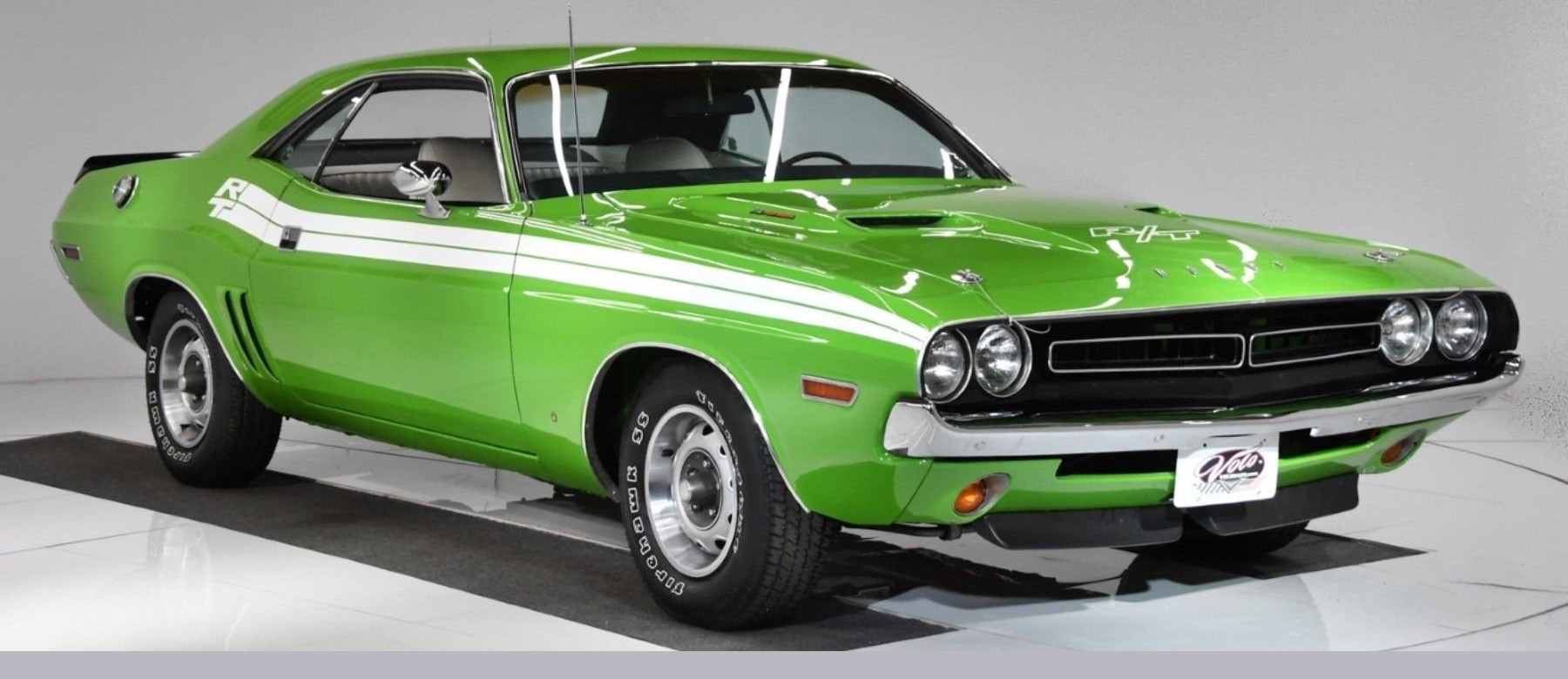 Dodge Challenger -- A sister to the ‘Cuda, with the same platforms, track widths, engines, and proportions, Challenger’s 110-inch wheelbase is two inches longer than the Plymouth’s and its overall length of 191.5 inches is three inches longer. The 1970 Dodge Challenger T/A and 1970 Plymouth AAR ’Cuda were the first American muscle cars with staggered tires—wider rubber in the back than the front …15-inch E60 white-letter Goodyears up front and wider G60s in back.
Dodge Challenger -- A sister to the ‘Cuda, with the same platforms, track widths, engines, and proportions, Challenger’s 110-inch wheelbase is two inches longer than the Plymouth’s and its overall length of 191.5 inches is three inches longer. The 1970 Dodge Challenger T/A and 1970 Plymouth AAR ’Cuda were the first American muscle cars with staggered tires—wider rubber in the back than the front …15-inch E60 white-letter Goodyears up front and wider G60s in back.  Plymouth GTX -- Plymouth introduced the GTX in 1967 as a luxury option in the Belvedere lineup to compete with the other luxury cars and was equipped with either a 440 Super Commando engine or the optional 426 Hemi.
Plymouth GTX -- Plymouth introduced the GTX in 1967 as a luxury option in the Belvedere lineup to compete with the other luxury cars and was equipped with either a 440 Super Commando engine or the optional 426 Hemi.  Dodge Coronet Super Bee -- The Coronet was an intermediate sedan in the Dodge lineup in the late ’60s, but the Coronet got a powerful engine, so it could be turned into a fast street fighter. Dodge presented the Super Bee model in 1968 as their answer to the Plymouth Road Runner and was outfitted with either a standard 383 or the 426 Hemi engine. The new 440 Six Pack engine, with three two-barrel Holley carburetors, became an option starting in mid-1969. The 440 four barrel was an option in 1971 only, the final year for the Super Bee.
Dodge Coronet Super Bee -- The Coronet was an intermediate sedan in the Dodge lineup in the late ’60s, but the Coronet got a powerful engine, so it could be turned into a fast street fighter. Dodge presented the Super Bee model in 1968 as their answer to the Plymouth Road Runner and was outfitted with either a standard 383 or the 426 Hemi engine. The new 440 Six Pack engine, with three two-barrel Holley carburetors, became an option starting in mid-1969. The 440 four barrel was an option in 1971 only, the final year for the Super Bee. Plymouth Superbird – A unique muscle car built with aerodynamics in mind, and a nose cone, hideaway headlights and huge back spoiler. The rear glass deviated from the standard concave shape with a wind-tunnel-tested flush design. The Superbird was built in 1970 only and was Plymouth’s way to lure Richard Petty back to the brand after he switched to Ford for ’69. Much like the Hemi in Pro Stock in 1972, the Superbird was defeated by a pencil as NASCAR changed the rules to make the “wing cars” less competitive.
Plymouth Superbird – A unique muscle car built with aerodynamics in mind, and a nose cone, hideaway headlights and huge back spoiler. The rear glass deviated from the standard concave shape with a wind-tunnel-tested flush design. The Superbird was built in 1970 only and was Plymouth’s way to lure Richard Petty back to the brand after he switched to Ford for ’69. Much like the Hemi in Pro Stock in 1972, the Superbird was defeated by a pencil as NASCAR changed the rules to make the “wing cars” less competitive. 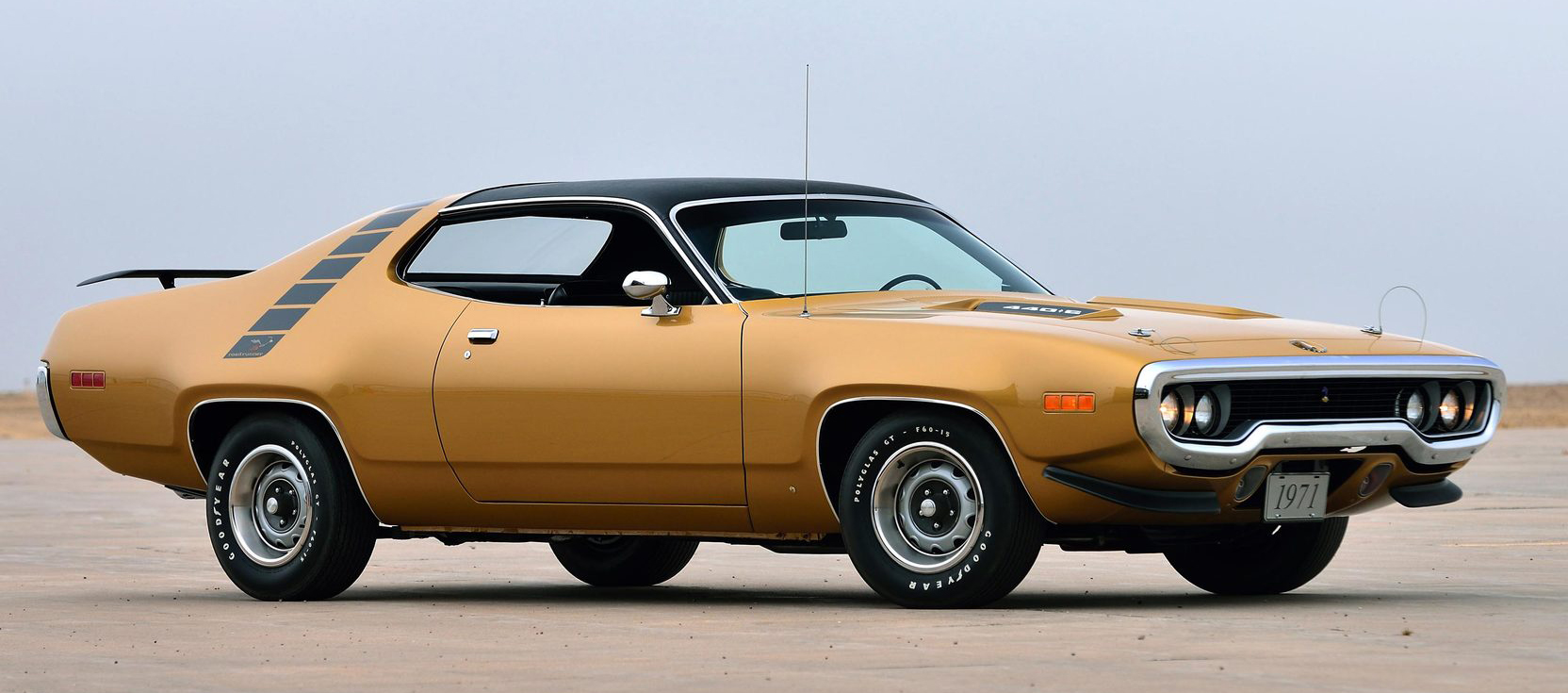 Plymouth Road Runner -- Road Runner models featured the animated bird character from Warner Bros. Road Runner was a low priced, creatively designed people pleaser with muscle. Road Runner started the trend as the first muscle car with creative graphics. The Road Runner had a bench seat, no luxury options, and manual steering, but was powered by a 383 V8 as the base engine, or Hemi 426. Just like Dodge’s Super Bee, the Road Runner received the 440 Six Barrel as an optional engine choice beginning in 1969 (Six Barrel is Plymouth’s name for an engine with three Holley two-barrel carbs).
Plymouth Road Runner -- Road Runner models featured the animated bird character from Warner Bros. Road Runner was a low priced, creatively designed people pleaser with muscle. Road Runner started the trend as the first muscle car with creative graphics. The Road Runner had a bench seat, no luxury options, and manual steering, but was powered by a 383 V8 as the base engine, or Hemi 426. Just like Dodge’s Super Bee, the Road Runner received the 440 Six Barrel as an optional engine choice beginning in 1969 (Six Barrel is Plymouth’s name for an engine with three Holley two-barrel carbs).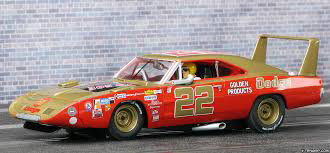
Dodge Charger Daytona – The Daytona was even faster at Daytona and Talladega NASCAR tracks than the Superbird. The Charger Daytona was one of the first cars developed in a wind tunnel using new materials in construction. The standard engine was a 440 V8 and had a 426 Hemi option. AMC Javelin -- American Motors hit the muscle scene from 1968-1970 with AMX and Javelin models. Tricked out with hip styling, AMX was a shortened Javelin with only two seats.
AMC Javelin -- American Motors hit the muscle scene from 1968-1970 with AMX and Javelin models. Tricked out with hip styling, AMX was a shortened Javelin with only two seats. 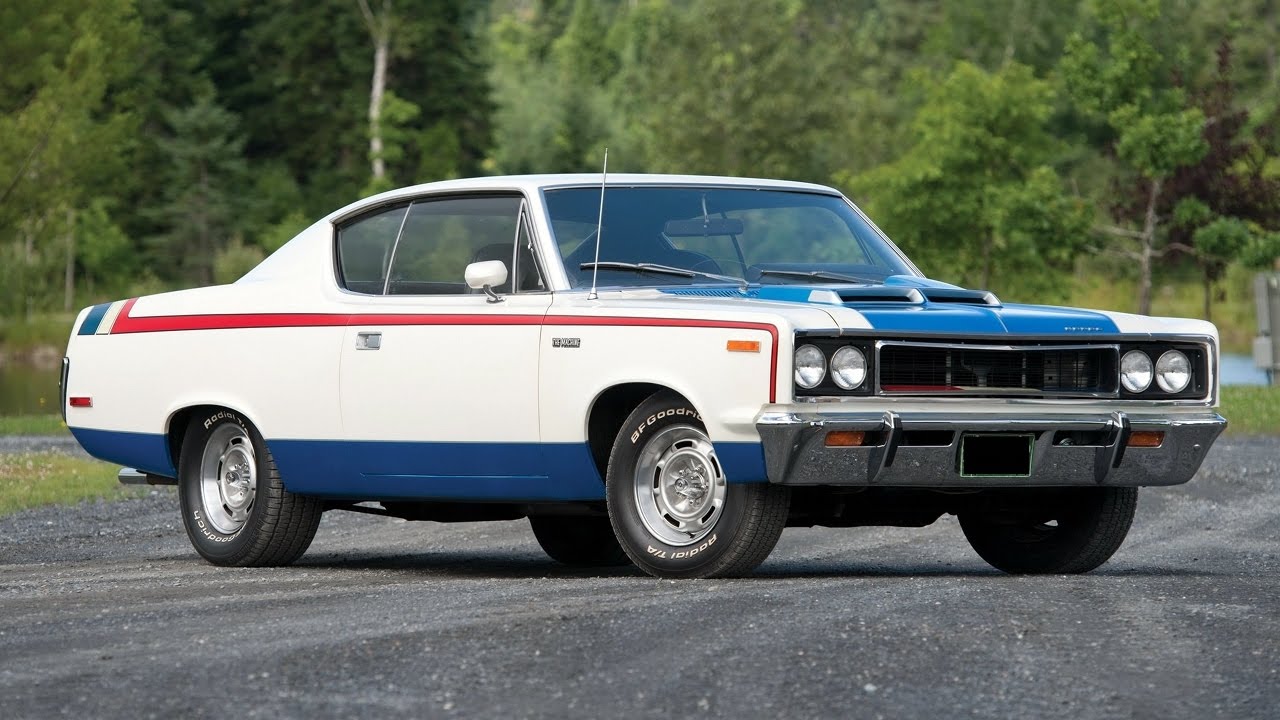 AMC Rebel – Once known as the Rambler Rebel, and replaced by the AMC Matador in 1971, Rebel’s top power model, “The Machine” was outfitted with a 340-hp 390 ci. V8.
AMC Rebel – Once known as the Rambler Rebel, and replaced by the AMC Matador in 1971, Rebel’s top power model, “The Machine” was outfitted with a 340-hp 390 ci. V8.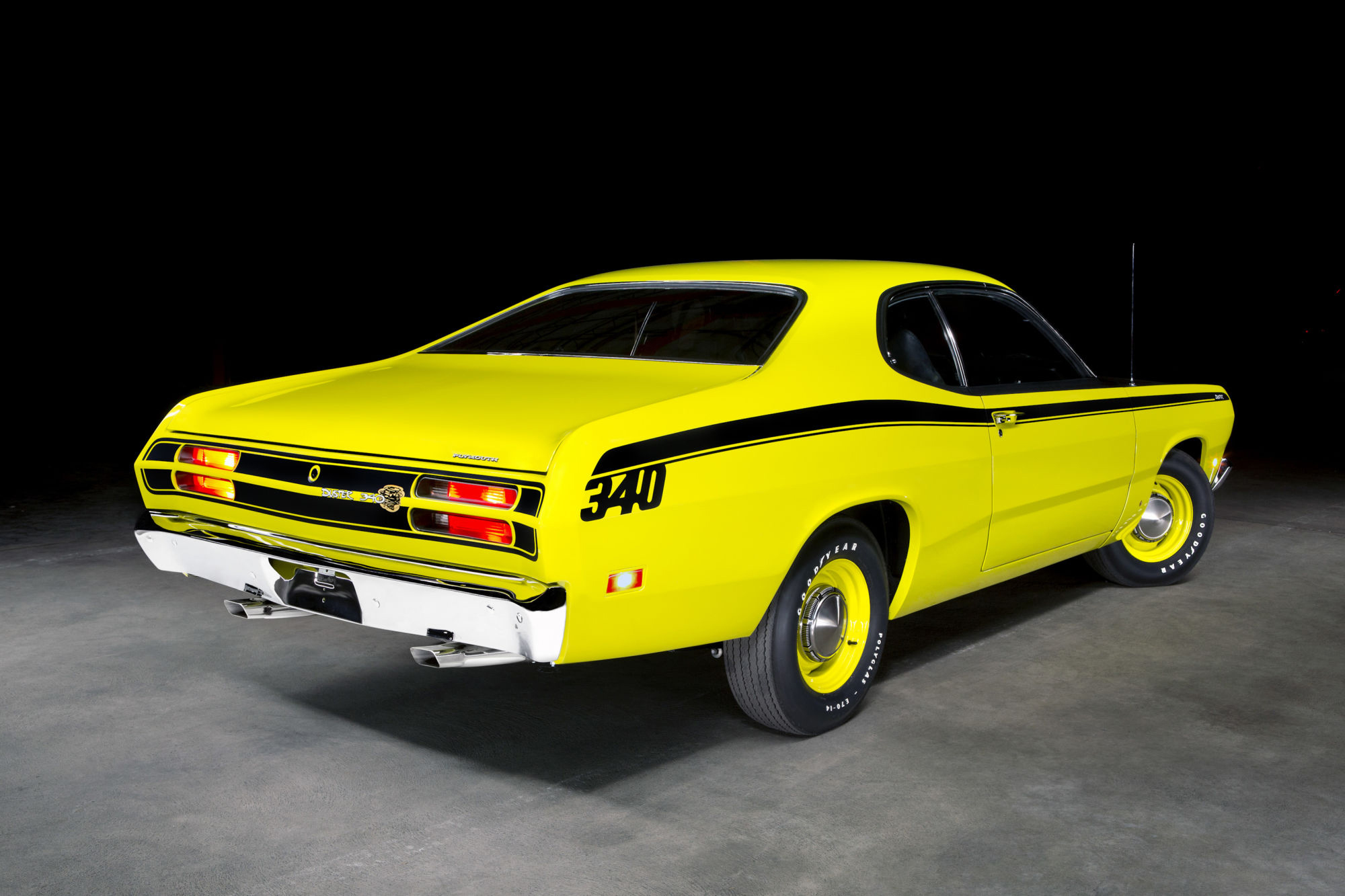 Plymouth Duster 340 – The Duster had all new sheet metal when it debuted in 1970 with its fastback styling, but underneath it was still a Valiant. In fact, in 1970, it was actually badged as a Valiant Duster. The largest available engine (1970-1973) was the 340. While never available with a big block, it’s no secret that a 340 Duster (or its Dodge sibling, the Swinger 340) when equipped with a 3.91 Sure Grip rear and a 4-speed transmission, could beat up on many big block intermediate cars.
Plymouth Duster 340 – The Duster had all new sheet metal when it debuted in 1970 with its fastback styling, but underneath it was still a Valiant. In fact, in 1970, it was actually badged as a Valiant Duster. The largest available engine (1970-1973) was the 340. While never available with a big block, it’s no secret that a 340 Duster (or its Dodge sibling, the Swinger 340) when equipped with a 3.91 Sure Grip rear and a 4-speed transmission, could beat up on many big block intermediate cars. Plymouth Fury GT -- A two-door coupe version of the Fury sedan, it had full-on power with a 440 V8, 375 horses. The Sport Fury GT was full-size muscle at its finest. In 1970, a handful of Sport Fury GTs were built with the 390 hp 440 Six Barrel.
Plymouth Fury GT -- A two-door coupe version of the Fury sedan, it had full-on power with a 440 V8, 375 horses. The Sport Fury GT was full-size muscle at its finest. In 1970, a handful of Sport Fury GTs were built with the 390 hp 440 Six Barrel.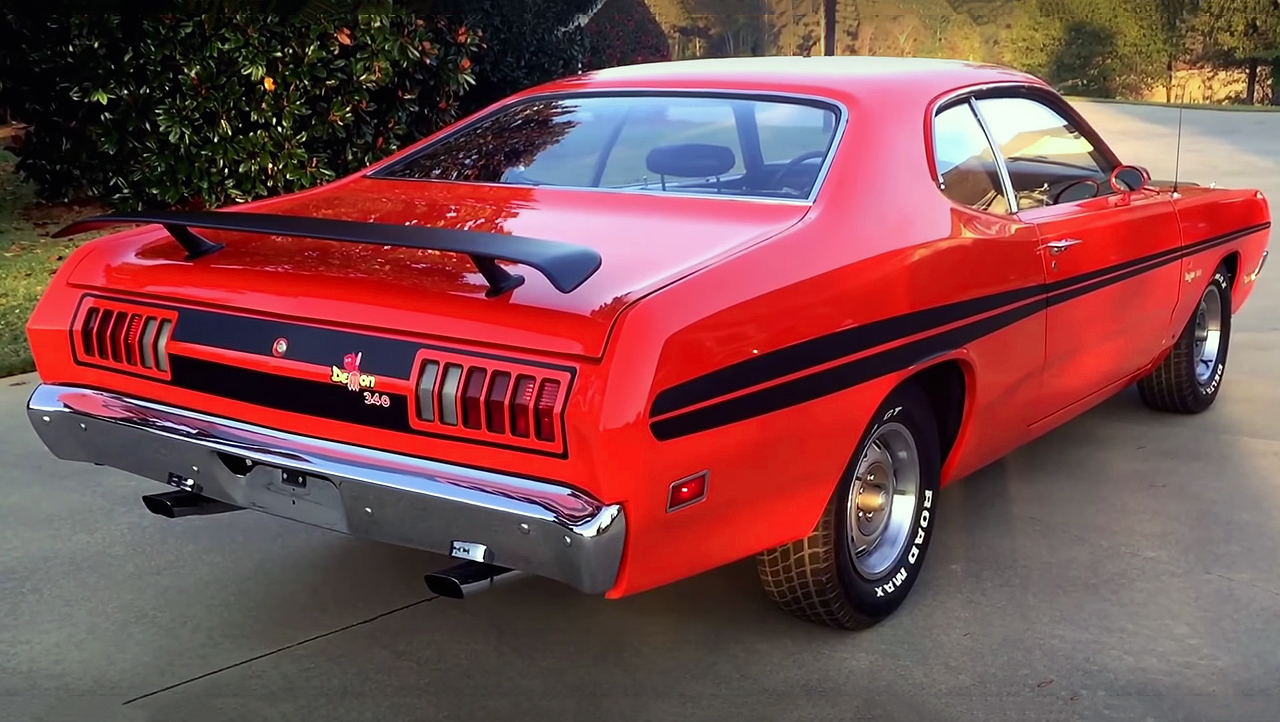 Dodge Demon -- The Demon was a new nameplate for 1971. The A-body Dodge Dart Demon for 1971 was offered with a 198- or 225-ci. Slant Six or the 318 V-8 engine, but it soon earned a reputation as a low-buck supercar in Demon 340 trim. The Demon started life as a Plymouth Duster shell, save for the Demon-only taillight panel, with Dodge Dart front sheet metal. Even the side marker lights and the wheel lips didn’t match from front to back because of the blending of the two different brands. But that never stopped the Demon from becoming a favorite among the Mopar faithful.
Dodge Demon -- The Demon was a new nameplate for 1971. The A-body Dodge Dart Demon for 1971 was offered with a 198- or 225-ci. Slant Six or the 318 V-8 engine, but it soon earned a reputation as a low-buck supercar in Demon 340 trim. The Demon started life as a Plymouth Duster shell, save for the Demon-only taillight panel, with Dodge Dart front sheet metal. Even the side marker lights and the wheel lips didn’t match from front to back because of the blending of the two different brands. But that never stopped the Demon from becoming a favorite among the Mopar faithful. More ’Cudas – The Plymouth Barracuda 440 V8 was a monster pony car, with 375 horses and a tight build. The AAR ‘Cuda was a limited-production model to commemorate Dan Gurney’s All American Racing team, which used ‘Cudas in the Trans Am championship. It came with a 340 V8 small block, with three two-barrel Holley carburetors, a rear spoiler and unique side graphics that included the big AAR logo.
More ’Cudas – The Plymouth Barracuda 440 V8 was a monster pony car, with 375 horses and a tight build. The AAR ‘Cuda was a limited-production model to commemorate Dan Gurney’s All American Racing team, which used ‘Cudas in the Trans Am championship. It came with a 340 V8 small block, with three two-barrel Holley carburetors, a rear spoiler and unique side graphics that included the big AAR logo. That’s a quick look and you can see all variations of Mopar culture as a showcase of 1971 Mopar muscle at the Carlisle Chrysler Nationals at Carlisle, PA Fairgrounds, July 9-11.
> Visit www.CarlisleEvents.com for more on the automotive hobby.
Mike Blake, former editor of KIT CAR magazine, joined Carlisle Events as senior automotive journalist in 2004. He's been a "car guy" since the 1960s and has been writing professionally for about 30 years.
-

Carlisle Events Welcomes eBay as Presenting Partner
Monday, Mar 22, 2021
Carlisle Events and its automotive flea market events have been a staple in automotive circles since 1974. Fall Carlisle, the flagship event …
Show MoreCarlisle Events and its automotive flea market events have been a staple in automotive circles since 1974. Fall Carlisle, the flagship event for the company and its slightly younger sister, Spring Carlisle, have been connecting buyer and seller with automotive pieces, parts, collectibles, merchandise and more for decades. Meanwhile, the internet as we know it began to take shape in the ‘90s and with it, online shopping anchored by eBay (launched in 1995). While there are many outlets that offer both in-person car events and online shopping, there aren’t two bigger options than Carlisle Events and eBay. Beginning with Spring Carlisle (April 21-25), Carlisle Events and eBay come together to bring an infinite array of options to the consumer, while also helping to bring the consumer up to speed with all that eBay has to offer.
eBay will be recognized as the presenting sponsor of Spring Carlisle and Fall Carlisle. In addition, eBay joins great partners like A&A Auto Stores, Amsoil, Meguiar’s, RockAuto.com and American Collector Car Insurance as official season-long sponsors.
eBay and Carlisle Events have roots dating back as early as 2000. eBay Motors launched and soon thereafter, introduced their online marketplace to Carlisle Events as an official sponsor in 2002. For many years after, they worked directly with Carlisle Events and showgoers on the ins and outs of buying and selling online. Since the initial partnership, online buying and selling various products has become commonplace, including by every one of the aforementioned Midway vendors and even Carlisle Events by way of an overstock merchandise eBay store.
Carlisle Events welcomes them back to share their online selling experience and be part of the overall market of buying and selling “car stuff.” Guests will find them and their marketplace experts on the midway at many events this season. While at Carlisle, everyone is encouraged to learn more about continued sales once in-person events conclude, all while eBay’s 24/7 online market remains open, benefiting everyone, not only at Carlisle but around the world!
“Online marketplaces through websites and applications, such as our partner eBay, are a fixture of business today,” noted Ed Scholly, director of Business and Event Development. “They exist as part of the overall market, which includes the communities, vendors and enthusiasts taking part in offline experiences such as Carlisle’s events. We are excited to see this convergence at Carlisle and further our online and offline connections as we buy, sell and trade throughout the year.”
“In light of eBay and Carlisle’s 20-year history, we’re thrilled to be returning as an official sponsor of Spring and Fall Carlisle,” said Ron Jaiven, GM of eBay Motors. “eBay and Carlisle share a longstanding dedication to helping auto enthusiasts everywhere find exactly what they’re looking for – and as eBay continues to evolve its offering to make both the selling and buying experience better and simpler, we’re as committed as ever to delivering an unparalleled experience on the marketplace, surfacing the unique and not so unique vehicles and parts and accessories that motors enthusiasts are coveting.”
Carlisle Events is COVID-19 compliant and follows current guidelines suggested by state officials as well as the Centers for Disease Control (CDC). A detailed Health/Safety Measures summary is available on CarlisleEvents.com. While on the web, be sure to learn more about Spring Carlisle, register to become a vendor, sell in the car corral, or purchase discounted spectator tickets in advance of the event or call 717-243-7855 to learn more today.
Book with a preferred Hotel

Book online or call (800) 216-1876



